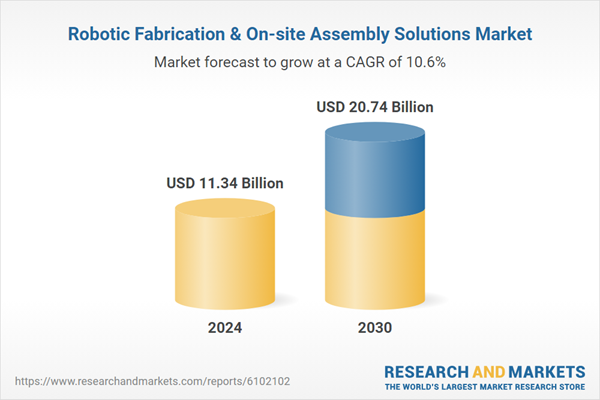Speak directly to the analyst to clarify any post sales queries you may have.
10% Free customizationThis report comes with 10% free customization, enabling you to add data that meets your specific business needs.
These solutions utilize technologies such as robotic arms, autonomous platforms, 3D printing systems, and machine vision to automate tasks like welding, bricklaying, façade installation, and modular assembly. Their adoption is being driven by a global shortage of skilled labor, rising demands for faster and more accurate project delivery, and increasing emphasis on worker safety and cost efficiency. The integration of robotic systems with digital tools like Building Information Modeling (BIM) and AI-based planning allows for seamless coordination between virtual design and physical execution, helping optimize construction workflows and outcomes.
Key Market Drivers
Acute Labor Shortages and Rising Labor Costs
The construction sector is facing a growing shortage of skilled labor, with fewer young workers entering trades and a significant portion of the current workforce nearing retirement. In response, companies are turning to robotic fabrication and on-site assembly systems to offset this deficit. These automated technologies can execute repetitive and hazardous construction tasks - such as masonry, rebar tying, and panel assembly - with consistency and speed, helping maintain project timelines even with limited staff.Rising labor costs, driven by wage inflation and regulatory requirements, further reinforce the economic appeal of automation. Robotic solutions reduce dependency on fluctuating labor markets, cut down on overtime expenses, and enable human workers to focus on quality control and supervision. As construction labor becomes costlier and harder to secure - particularly in developed regions - automation is no longer a luxury but an essential strategy. Data from the U.S. Bureau of Labor Statistics indicates a 27% increase in hourly wages in construction from 2016 to 2024, with over 40% of skilled workers projected to retire by 2030, heightening the urgency for automation adoption.
Key Market Challenges
High Capital Investment and ROI Uncertainty
One of the primary obstacles hindering wider adoption of robotic construction systems is the significant upfront capital required. The expense of acquiring and implementing robotic arms, mobile platforms, 3D printing units, and sensory equipment can be prohibitively high, especially for small and mid-sized firms. Beyond equipment costs, companies must invest in skilled personnel, system integration with software like BIM, customization, and ongoing maintenance. For firms operating on slim profit margins, justifying these investments without immediate and measurable returns can be difficult. The financial risk associated with large-scale automation often makes adoption more feasible for larger contractors or those backed by substantial capital, leaving others hesitant to commit.Key Market Trends
Rise of Modular and Prefabricated Construction Enabled by Robotics
Robotic technologies are playing a pivotal role in accelerating the shift toward modular and prefabricated construction. By integrating advanced fabrication systems into off-site manufacturing environments, firms can produce components such as walls, floor panels, and complete room modules with high precision and minimal waste. These systems support mass customization, allowing parts to meet specific design criteria while maintaining scalable production efficiency. Once fabricated, modules are transported and assembled on-site using robotic cranes and automated alignment tools, significantly reducing labor reliance and improving safety. This trend is especially prominent in fast-paced segments like urban infrastructure, healthcare facilities, and affordable housing. As cities seek scalable, sustainable construction solutions, robotic-driven modular construction is becoming a key enabler of next-generation building practices.Key Market Players
- ABB Ltd.
- KUKA AG
- FANUC Corporation
- Boston Dynamics, Inc.
- Trimble Inc.
- Autodesk, Inc.
- Built Robotics, Inc.
- ICON Technology, Inc.
Report Scope:
In this report, the Global Robotic Fabrication & On-site Assembly Solutions Market has been segmented into the following categories, in addition to the industry trends which have also been detailed below:Robotic Fabrication & On-site Assembly Solutions Market, By Component:
- Hardware
- Software
- Services
Robotic Fabrication & On-site Assembly Solutions Market, By Technology:
- Additive Manufacturing
- Automated Welding & Joining
- AI-Driven Assembly Planning
- Computer Vision for Quality Inspection
- BIM-integrated Robotics
- Autonomous Mobile Robots
Robotic Fabrication & On-site Assembly Solutions Market, By Application:
- Prefabrication of Structural Components
- 3D Concrete Printing
- Modular Unit Assembly
- Bricklaying & Masonry
- Others
Robotic Fabrication & On-site Assembly Solutions Market, By Region:
- North America
- United States
- Canada
- Mexico
- Europe
- Germany
- France
- United Kingdom
- Italy
- Spain
- Asia Pacific
- China
- India
- Japan
- South Korea
- Australia
- Middle East & Africa
- Saudi Arabia
- UAE
- South Africa
- South America
- Brazil
- Colombia
- Argentina
Competitive Landscape
Company Profiles: Detailed analysis of the major companies present in the Global Robotic Fabrication & On-site Assembly Solutions Market.Available Customizations:
With the given market data, the publisher offers customizations according to a company's specific needs. The following customization options are available for the report.Company Information
- Detailed analysis and profiling of additional market players (up to five).
This product will be delivered within 1-3 business days.
Table of Contents
Companies Mentioned
- ABB Ltd.
- KUKA AG
- FANUC Corporation
- Boston Dynamics, Inc.
- Trimble Inc.
- Autodesk, Inc.
- Built Robotics, Inc.
- ICON Technology, Inc.
Table Information
| Report Attribute | Details |
|---|---|
| No. of Pages | 185 |
| Published | June 2025 |
| Forecast Period | 2024 - 2030 |
| Estimated Market Value ( USD | $ 11.34 Billion |
| Forecasted Market Value ( USD | $ 20.74 Billion |
| Compound Annual Growth Rate | 10.5% |
| Regions Covered | Global |
| No. of Companies Mentioned | 8 |









